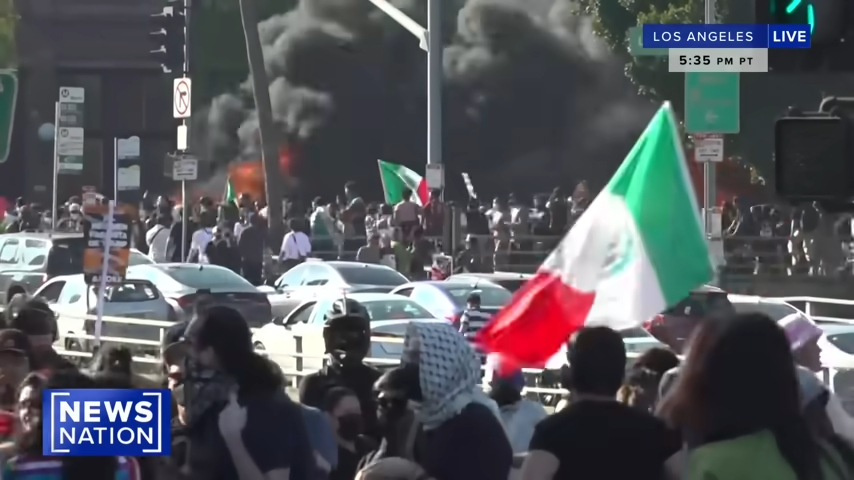The past weekend saw one of America’s best-known and, for a long time, best-loved cities erupt in violent riots. Fires raged across Los Angeles as rioters waving foreign flags hurled everything from rocks and concrete slabs to fireworks and Molotov cocktails at federal law enforcement agents. Why? Those agents were tasked with carrying out the mass deportation agenda that played a key role in getting President Donald Trump elected a second time in a historic landslide victory. In other words, illegal immigrants waved Mexican flags, burned American flags, terrorized an American city, and assaulted officers of American law in order to… stay in America and not be sent back to the country whose flag they were waving.
These are not rioters fighting to stay in the adopted nation they now call home, but foreign invaders who have claimed our nation as their own.
It doesn’t make sense. At first glance, it even seems comically illogical and cognitively dissonant. But a second or maybe even a third glance quickly reveals the far less comical truth: These are not rioters fighting to stay in the adopted nation they now call home, but foreign invaders who have claimed our nation as their own. They are not throwing a tantrum because they don’t want to be sent home — as far as they’re concerned, they are home, and federal forces are trying to reclaim the land that they so easily conquered. (RELATED: The Party of Anarchy)
U.S.–Mexico: National Migration Policy
What is today called California was once part of Mexico, following the 1821 Mexican War of Independence, but was a full-fledged American state by 1850. Over the next half-century, the U.S. was still determining and formalizing its immigration, but the creation of the U.S. Border Patrol (USBP) in 1924 denoted a more serious approach to securing the nation’s borders. In the 1930s, in the face of the economic brutalities of the Great Depression, President Herbert Hoover moved to severely curtail immigration, including effecting the voluntary and forced repatriation of millions of immigrants who had come into the country relatively recently.
From then until the mid-1960s, the U.S. and Mexico had an agreement allowing Mexican workers to temporarily visit and work in the U.S. to meet certain low-skill labor demands. Especially in California and Los Angeles, this meant working on orchards, harvesting oranges and other produce. When the program was terminated in 1964, however, the travel networks used by Mexican laborers largely remained in place, enabling many Mexicans to illegally enter the U.S. and approach their old employers.
The 1952 Immigration and Nationality Act and the aggressive 1954 Operation Wetback did little to address the issue of continuing illegal immigration, although the former allowed for the deportation of those in the U.S. illegally and the latter specifically targeted Mexican laborers in southern California. But with migration networks still in operation, it was only a matter of time before at least one million who were deported returned.
The Immigration and Nationality Act of 1965 placed more severe limits on legal entry into the U.S., but still failed to break the migration networks so many were using to enter the U.S. illegally. L.A. adopted certain “sanctuary” policies in the 1970s, becoming a sort of haven for illegal immigrants. (RELATED: Sanctuary Cities: The Dangerous Illusion of Virtue)
By the time Ronald Reagan was in the White House, there were millions of illegal immigrants in the U.S. Most of the Mexican nationals were centered in Los Angeles, due partly to the city’s proximity to the border, partly to its labor market, and partly due to networks established there by Mexicans in the days when immigration law was much less clearly defined and vigorously enforced.
The “invasion” witnessed even today, polluting the streets of L.A. with violence and mayhem, may have been initiated a century ago or a half-century ago, but its insurgent nature became clear about 30 years ago.
In 1994, California voters approved Prop. 187, which ensured that taxpayer-funded services such as public education and healthcare were not provided to illegal immigrants. A federal judge struck down the measure, somehow arguing that immigration was the purview of the federal government and that the state, therefore, had to incentivize illegal immigration on the taxpayers’ dime.
In cities like Los Angeles, the immigrant population overwhelmingly began voting for candidates and politicians who supported immigrants — legal or otherwise. As immigration enforcement ramped up in the late 1990s and 2000s, L.A. became an illegal immigration destination, a safe harbor for those who otherwise faced arrest and deportation.
The most recent L.A. riots are, in part, the result of noncomprehensive immigration policy and enforcement, but, far more significantly, of a foreign people effectively taking over the second-largest U.S. city and remaking it in their own image. This is no simple matter of a handful of rowdy thugs trying their luck at taking on the city’s police force. This is a matter of an extraordinarily high volume of generations of insurgents being told that they have to leave the city they captured decades ago.
These riots pose a crucial and fundamental question for Americans: Do we have a nation? We ought to. We have a Constitution and thousands of legal documents and court rulings — not to mention hundreds of years of our ancestors’ blood, sweat, tears, and toils — that all say we have a nation. But whether or not we have a nation de jure, the response to L.A. will decide whether or not we have a nation de facto.
If American cities can be systematically taken over and turned into satellites of foreign nations, if American authorities are not allowed to expel the invaders, then we do not have a nation, simply a constellation of satellites-in-making for foreign entities to take over and claim as their own. Do we have a nation? Or are we ripe for the third world’s pillaging?
READ MORE from S.A. McCarthy:
Christopher Wray Lied: The FBI Was Targeting American Catholics





















